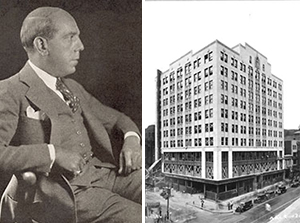When the famed Brill Building changed hands for nearly $300 million this summer, its role in 20th Century American popular music was duly noted. But few reports mentioned the man who built it, Abraham Lefcourt.
That would have been inconceivable in the 1920s. Lefcourt, an active developer prior to the Great Depression, at one point held more property than any other Midtown landowner. He lived large, and like many contemporaries, had a tragic fall when the economy collapsed following the 1929 crash.
Lefcourt started his development career by building a “towering” 12-story garment factory at 48-54 West 25th Street in 1910.
By 1924, the one-time shoeshine boy owned much of the area between 35th and 39th streets west of Broadway, valued at over $100 million (that would be a staggering $7.07 billion today).
By 1930, he had completed 31 buildings, 20 in Manhattan, including lofts, apartment buildings and office towers. His total investment came to “well over a quarter of a billion dollars,” the New York Times wrote in 1930. Many of his structures bore his name, including the 26-story Lefcourt Clothing Center at Seventh Avenue and 25th Street, which became the anchor for the Garment District. The landmark Essex House on Central Park South is one of at least 17 of his buildings that remain.
“No other single individual or building organization has constructed … as many buildings as are in the Lefcourt group,” the 1930 Times story said.
Jason Cochran, a journalist and self-described pop historian, called Lefcourt, “The Donald Trump of Roaring ‘20s Manhattan,” for his flamboyant lifestyle, high-profile developments and the fact that “he grandly affixed his own name to many of them to secure his own reputation.” The developer even started his own bank, the Lefcourt Normandie National Bank, in 1928.
But Lefcourt’s 32nd project at Broadway and 49th Street, on a property sublet from the Brill Brothers, a men’s clothing store, was a turning point.
At the start of construction in 1929, he declared it would be the world’s tallest, though no plans were filed to show how that might be accomplished. Instead, his effort to compete with the Chrysler Building and Empire State Building, which were both rising at the time, was tinged with tragedy. By 1930, the Great Depression was draining his wealth and Lefcourt faced heartbreak in the death of his 17-year-old son, Alan.
Instead of building the world’s tallest building, he filed plans for a 10-story Art Deco office building. He named his last property the Lefcourt-Alan Building.
By 1931, Lefcourt had defaulted on his sublease and the Brills took over the property. The building took their name, though it still bears a bronze bust of Alan over the door.
Lefcourt died
